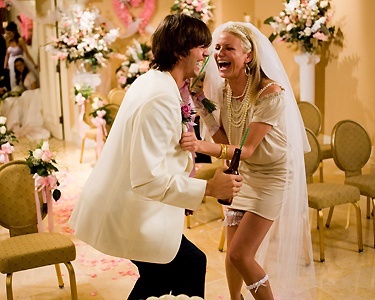By: Graham Wyatt

What Happens in Vegas
is a modern day rom-com starring Ashton Kutcher and Cameron Diaz. Off to Las
Vegas goes two cahracters who have, in their minds, hit rock bottom. The story involves them partying together and
drunkenly getting married in a night that neither of them have much
recollection of. Right after their marriage, one of them wins $3,000,000 and it
results in a legal battle for the money. The majority of the plot follows the
two after the judge’s ruling, which required them to live and act as a married
couple for six months in order to at least give their marriage a try; so you can
imagine the shenanigans that ensued!
Most of the
movie was set in modern-day New York City, so there was copious amounts of
product placement, both intentional and non-intentional, throughout the city.
Before I go into that, I’d like to point out the portion of the film that was
set in Vegas. There was a point where they rode a limo down the strip and panned
over almost every major casino including: The Venetian, MGM Grand, the
Bellagio, and the Wynn, among others I didn’t recognize. I feel like just about
every scene outside on the town featured The Bellagio’s fountains in the
background, so they received a ton of screen time for their famous fountains. The
casino and hotel room/check-in part of the plot was filmed at the Planet Hollywood Casino
(you get it? cause it’s a Hollywood film;).
Something I found interesting while researching the film was that the
title was conceived by the Las
Vegas Convention and Visitors Authority, which is the official marketing
organization of Southern Nevada. This is crucial to why they were not shy about
including all of their big name Casino hotels, this was a huge marketing venture
for the state of Nevada because they rake in a ton of money
from taxes on their casinos. The casino recognition and title of the movie sum
up the product placement in the Las Vegas part.
Back in New
York, there is product placement all over. There is a chase scene through the
streets of Manhattan and we see every type of economy car you could imagine
(Honda Civic, Toyota Corolla, Nissan Altima, etc.), but what I really want to
focus on is the apartment that Ashton Kutcher and Cameron Diaz’s characters
live in. In this apartment there are Coca Cola decorations, a signed Spaulding
Basketball, and tons of Budweiser beer cans. In respect to the movie as a
whole, I firmly believe that Anheuser-Busch got the most recognition compared
to any other product placements. The only beer the characters are seen drinking
in the apartment is Bud Light, Budweiser and Michelob Ultra (made by a
subsidiary of Anheuser-Busch). There is also a neon sign hanging on the wall
that advertises Bare Knuckle Stout, an Irish dry ale that
Anheuser-Busch brews. This company being the primary product-placer in this
film goes along with the image that the director wants to portray Ashton
Kutcher’s character as a young, wild, party animal. This also is a good fit for
the brewing company because that is one of their target markets, young partiers
who can easily relate to the character in this film. As Martin Smith says in
his article, Name-Brand Props in Movies,
placement costs are typically between $10,000 and $80,000 with a few
exceptions. Now the stats aren’t out there, but based on the quantity and the
fact they were the only beer shown, I would bet Anheuser-Busch paid between 30
and 50 thousand dollars for this movie.

One product
placement flaw I noticed in the movie was one scene where Ashton Kutcher’s
character was shown eating a bowl of Heart to Heart cereal. This seems like a
contradiction to his character because he does not live a healthy lifestyle. I personally
would have found it more fitting if he was shown eating a super sugary cereal
like fruity pebbles or cocoa puffs. This was the only example of poor product
placement I saw in the film.
If I were
to rate the film based on the effectiveness of product placement I would give
it 4.5 stars, missing the full five only because of the cereal contradiction.

No comments:
Post a Comment